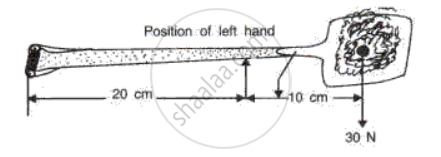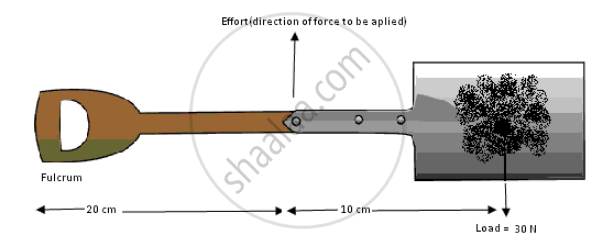Advertisements
Advertisements
प्रश्न
Fig. shows a spade. It is being used to lift soil weighing 30N from the ground.

(a) Mark the direction of the least force on the handle necessary to keep the spade balanced.
(b) Calculate the least force on the handle necessary to keep the spade balanced (the weight of the spade is negligible).
(c) If the left hand was move towards the soil on the spade, would the force on the handle necessary to keep the soil balance the greater or less? Give a reason for your answer.
(d) To which class of lever does the spade belong?
उत्तर
(a) Diagram showing the direction of application of least force on the handle:

(b) Given,load,L = 30 N
Let effort = E
Effort - arm = 20 cm
load - arm = 20 + 10 = 30 cm
Now, load x load - arm = effort x effort - arm
effort = `(30 xx 30)/20` = 45 N
(c) On moving the left hand towards the soil on the spade, the lenght of effort arm will increase and effort being inversely proportional to the lenght of effort arm, the force or effort necessary to keep the soil balanced would be less.
(d) A spade belongs to class III lever.
APPEARS IN
संबंधित प्रश्न
What is an ideal machine?
A machine is 75% efficient’. What do you understand by this statement?
The diagram below shows a wheel barrow. Mark position of fulcrum F and draw arrows to show the directions of load L and effort E. What class of lever is the whell barrow? Give one more example of the same class of lever.

Give an example of the following uses of a machine:
to obtain gain in speed
Can a simple machine act as a force multiplier and a speed multiplier at the same time?
Classify the following as a lever, a pulley and an inclined plane:
The wheel of a flagpole
Classify the following as a lever, a pulley and an inclined plane:
Nutcrackers
Which machine will you use to do the following work? Write their type.
To cut vegetables.
Which machine will you use to do the following work? Write their type.
To hold a papad for roasting it.
A pair of scissors is a _____ multiplier.
